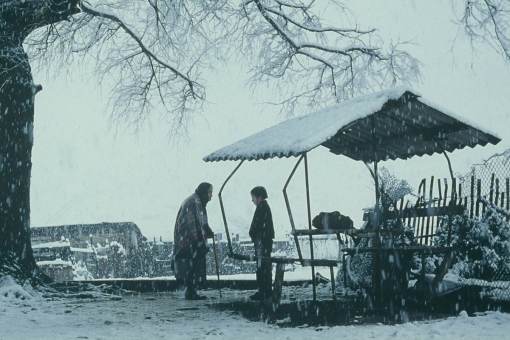 BIAFF management with support of GNFC (Georgian National Film Center) presents NEW GEORGIAN CINEMA at TOFIFEST Film festival (Poland) which takes place during 26 June - 2 July, 2010.
BIAFF management with support of GNFC (Georgian National Film Center) presents NEW GEORGIAN CINEMA at TOFIFEST Film festival (Poland) which takes place during 26 June - 2 July, 2010.BIAFF & GNFC Representatives will open NEW GEORGIAN CINEMA section at TOFIFEST on 28 June, 18.00.
One Georgian film - STREET DAYS by Levan Koguashvili is included in international competition section. The filmmaker will be also present at festival.
See more info and list of Georgian films presented at festival on TOFIFEST web-site:
http://www.tofifest.pl/en/program/p/8
NEW GEORGIAN CINEMA
Georgian film is a strange phenomenon, special, philosophically light, sophisticated and at the same time childishly pure and innocent. There is everything that can make me cry and I ought to say that it (my crying) is not an easy thing.
Federico Fellini, acclaimed Italian film director
 Georgia has a long history of cinematography which starts at the end of 19th century almost simultaneously with development of cinema in Europe. The first cinema opened in Tbilisi in 1896; by the early 1900s, there were several film theaters throughout Georgia. In 1908 enthusiast Vasili Amashukeli and Aleksndr Digmelov shot first experimental shots. In 1912 they directed the first full-length documentary film Akaki Tsereteli in Racha-Lechkhumi, which effectively marked the beginning of the Georgian film industry. In 1916, Alexander Tsitsunava made first feature film Kristine. In Georgia was shot the first in the Soviet Union full length three-dimensional film Robinson Kruso.
Georgia has a long history of cinematography which starts at the end of 19th century almost simultaneously with development of cinema in Europe. The first cinema opened in Tbilisi in 1896; by the early 1900s, there were several film theaters throughout Georgia. In 1908 enthusiast Vasili Amashukeli and Aleksndr Digmelov shot first experimental shots. In 1912 they directed the first full-length documentary film Akaki Tsereteli in Racha-Lechkhumi, which effectively marked the beginning of the Georgian film industry. In 1916, Alexander Tsitsunava made first feature film Kristine. In Georgia was shot the first in the Soviet Union full length three-dimensional film Robinson Kruso.In 1938, the Tbilisi Cinematographic Studio was established in Tbilisi. Many Georgian film directors emerged in this period, notably Mikheil Chiaureli — one of the most important Soviet filmmakers in the 1940. In the 1950s-1960s, Georgian Film studio was established and young generation of talented directors and screenwriters emerged during this period.
Georgian films differed from Soviet films by their expression and graphic forms. The period between the late 1960s and the 1980s was the golden age of the Georgian film industry, which produced up to 60 films a year. In 1972, the Faculty of Cinema was established at the Shota Rustaveli Institute of Theater and later developed into the Tbilisi Institute of Theater and Film. The studio employed many talented and prominent directors. Some of the films produced in this period were censored and kept from public release. During the whole history of Georgian cinematography more than 1000 films were created. Georgian cinema was well respected and has enjoyed wide popularity at many international festivals and forums: Cannes, Berlinale, Oberhousen, Venice, Rome and so on. At various film festivals Georgian films got more than 100 awards.
After the collapse of the Soviet Union, Georgian cinematography suffered difficult period. The financing was catastrophically decreased, for almost 10 years the cinema industry was not technically developed. Most of Georgian film directors continued their work abroad. Different institutions taught just theory of cinematography and just few experienced and talented film directors worked there. The result was deplorable and Georgian cinema industry almost stopped producing new movies.
In early 2000s the situation started to change step-by-step and modern Georgian cinematography, in spite of difficult period, still continues its development. In the last period, films are shot generally by new generation of talented filmmakers such as: Dito Tsintsadze, Levan Koguashvili, Giorgi Ovashvili, Zaza Urushadze, Aleko Tsabadze, etc. Many of them have received a lot of international film festivals awards.
The Georgian section at TOFIFEST is represented by six new films. Majority of them touch upon various problems existing in modern Georgia. Levan Koguashivili’s Women from Georgia and Salome Aleksi-Meskhishvili’s Felicita address the problems of immigrant women living and working abroad (USA and Italy respectively). In Street Days (Levan Koguashvili) various social problematic, drug addiction issues are depicted. The Other Bank by George Ovashvili tells story of 12 years old boy, who belongs to the generation, which was subject to mass displacement during civil war in Abkahzia region. Salome Jashi’s film The Leader Is Always Right shows patriotic camps where high school children spent around two weeks and where leader is always right ideology is cultivated. The film Three Houses (Zaza Urushadze) consists of three novels united by a story of the picture encompassing three cenuries
We hope that New Georgian Cinema section will be interesting and well accepted by audience at TOFIFEST. On behalf of BIAFF we want to express our gratitude to TOFIFEST for giving us an opportunity to present modern Georgian cinema to the Polish (and not only) audience.
Giorgi Gogiberidze and Zviad Eliziani
BIAFF (Batumi International Art-House Film Festival)
Curators of New Georgian Cinema Section
Felicità Felicitàdir. Salomé Aleksi, Georgia 2009, 30’
The Leader is Always Right Lideri Khoveltvis Martaliadir. Salome Jashi, Georgia 2010, 43’
The Other Bank Gagma Napiridir. George Ovashvili, Georgia, Kazakhstan 2009, 90’
Three Houses Sami Sakhlidir. Zaza Urushadze, Georgia 2008, 96’
Women from Georgia Kalebi Sakartvelodandir. Levan Koguashvili, Georgia 2009, 54’











1 comment:
wow that's awesome!
I think it would be a GREAT Film Festival!
Post a Comment